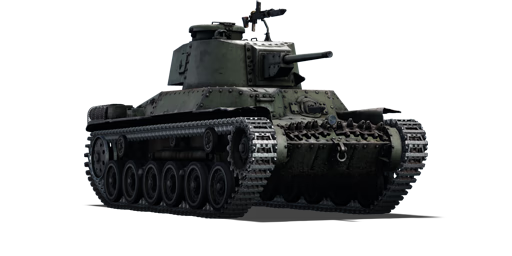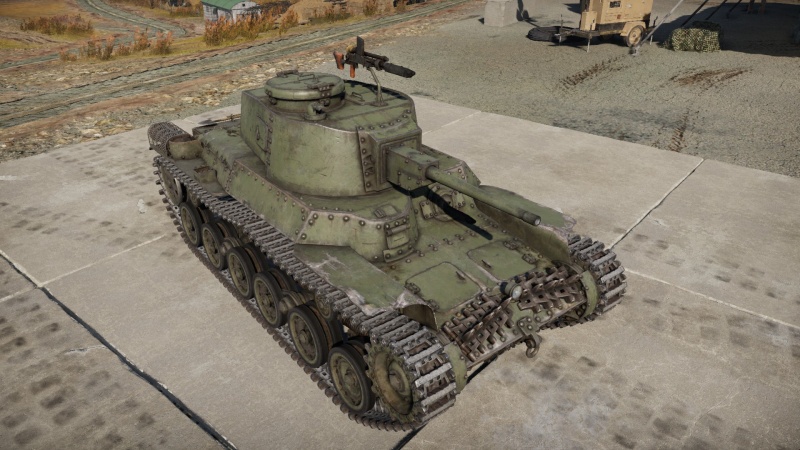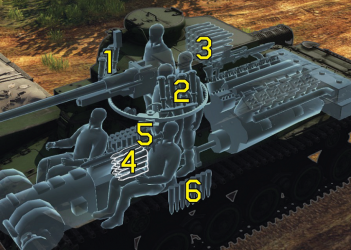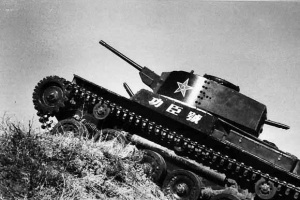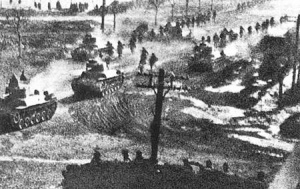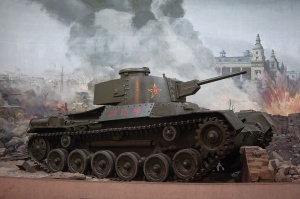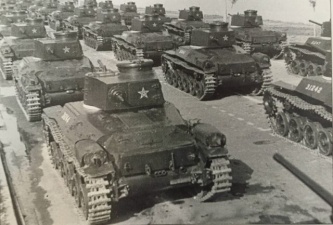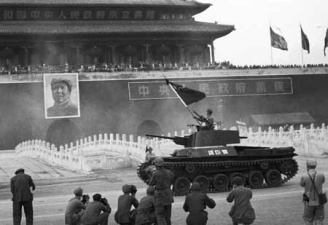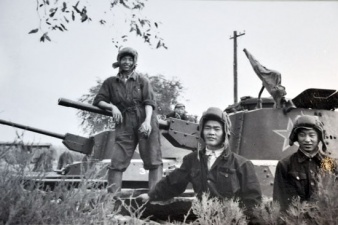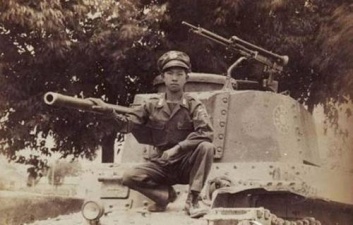Difference between revisions of "Chi-Ha Kai (China)"
(→Description) (Tag: Visual edit) |
m (Grammar) (Tag: Visual edit) |
||
| (29 intermediate revisions by 10 users not shown) | |||
| Line 1: | Line 1: | ||
| − | {{Specs-Card|code=cn_type_97_kai}} | + | {{About |
| + | | about = medium tank '''{{PAGENAME}}''' | ||
| + | | usage = other variants | ||
| + | | link = Chi-Ha (Family) | ||
| + | }} | ||
| + | {{Specs-Card | ||
| + | |code=cn_type_97_kai | ||
| + | |images={{Specs-Card-Image|GarageImage_{{PAGENAME}}.jpg}} | ||
| + | }} | ||
== Description == | == Description == | ||
<!-- ''In the description, the first part should be about the history of the creation and combat usage of the vehicle, as well as its key features. In the second part, tell the reader about the ground vehicle in the game. Insert a screenshot of the vehicle, so that if the novice player does not remember the vehicle by name, he will immediately understand what kind of vehicle the article is talking about.'' --> | <!-- ''In the description, the first part should be about the history of the creation and combat usage of the vehicle, as well as its key features. In the second part, tell the reader about the ground vehicle in the game. Insert a screenshot of the vehicle, so that if the novice player does not remember the vehicle by name, he will immediately understand what kind of vehicle the article is talking about.'' --> | ||
| − | + | The '''Type 97 Chi-Ha Kai''' ({{Annotation|九七式中戦車 改「チハ」|Kyūnana-Shiki Chū-Sensha Kai [Chi-Ha]}}) is a World War II Japanese medium tank that was an upgrade to the original [[Chi-Ha|Type 97 Chi-Ha]]. The [[Chi-Ha Kai|Type 97 Chi-Ha Kai]] ("improved") or {{Annotation|Shinhōtō|新砲塔}} Chi-Ha ("new turret" Chi-Ha) was equipped with a Type 1 47 mm anti-tank gun and was often regarded as the best Japanese tank to have seen combat service during the Pacific War. Many Soviet-captured Japanese tanks were delivered to the Chinese People's Liberation Army. By 1949, the People's Liberation Army had 349 tanks, including Type 97 Chi-Ha Kai tanks. The Type 97 Chi-Ha Kai tanks were also instrumental in the official formation of the Chinese People's Liberation Army's first tank brigade. On December 1, 1945, Gao Ke of the Northeast People's Autonomous Army (later renamed the Northeast Democratic Alliance Army) captured two Japanese Type 97 modified (Chi-Ha Kai) medium tanks from the Japanese "918" repair factory in Shenyang. They were designated as No. 101 and No. 102, respectively. With these two tanks, the People's Army officially formed the first tank brigade, the Northeast Tank Brigade. | |
| − | {{ | + | |
| − | + | Introduced in [[Update 1.91 "Night Vision"]], the Chi-Ha Kai medium tank offers significant enhancements over the preceding Chi-Ha medium tank, particularly in anti-tank capabilities. Concerned by the conflicts taking place in Europe during late World War II, the Japanese were concerned that greater anti-tank capabilities on their current tanks would be required to resist the expected intervention of the Allies in Asia. The Chi-Ha Kai, armed with a high-velocity 47 mm gun, was the first Japanese medium tank designed with tank-to-tank combat in mind. This captured Japanese medium tank, as a versatile and fast medium tank, will undoubtedly strengthen the Chinese Army's ground forces capabilities in the early ranks. | |
== General info == | == General info == | ||
=== Survivability and armour === | === Survivability and armour === | ||
| − | <!--Describe armour protection. Note the most well protected and key weak areas. Appreciate the layout of modules as well as the number and location of crew members. Is the level of armour protection sufficient, is the placement of modules helpful for survival in combat? If necessary use a visual template to indicate the most secure and weak zones of the armour.--> | + | {{Specs-Tank-Armour}} |
| + | <!-- ''Describe armour protection. Note the most well protected and key weak areas. Appreciate the layout of modules as well as the number and location of crew members. Is the level of armour protection sufficient, is the placement of modules helpful for survival in combat? If necessary use a visual template to indicate the most secure and weak zones of the armour.'' --> | ||
| + | |||
| + | The Chi-Ha Kai has little to no armour against its common opponents like the [[Pz.II (Disambiguation)|Pz.II]]. It has only 25 mm of armour on the turret cheeks and the frontal plate, and 20-25 mm at the hull sides. Its thin armour might only, with some luck, bounce off some autocannon shells while angling, or block the low penetration shells from a distance. Unfortunately, when being hit and penetrated, the Chi-Ha Kai is usually destroyed with one or two shots. However, this tank has a fairly small frontal profile, making it harder to be hit. Also, for the guns lacking post-penetration damage, the Chi-Ha Kai has an acceptable survivability, as it has a total of 5 crews and they are fairly spaced out due to the long hull. The huge transmission system at the front of the tank can also serve as further protection for the crew members, at the price of making the tank immobile and thus vulnerable. | ||
| + | |||
| + | '''Armour type:''' | ||
| − | + | * Rolled homogeneous armour | |
| + | |||
| + | {| class="wikitable" | ||
| + | |- | ||
| + | ! Armour !! Front !! Sides !! Rear !! Roof | ||
| + | |- | ||
| + | | Hull || 25 mm (11-31°) ''Front plate'' <br> 15-17 mm (62-80°) ''Front glacis'' <br> 15 mm (37-59°) ''Lower glacis'' || 25 mm (25-40°) ''Top'' <br> 25 mm ''Bottom'' || 15 mm (69°) ''Top'' <br> 20 mm (5-57°) || 12 mm | ||
| + | |- | ||
| + | | Turret || 25 mm (9-10°) ''Turret front'' <br> 30-35 mm ''Gun mantlet'' || 25 mm (9-10°) || 25 mm || 10 mm | ||
| + | |- | ||
| + | | Cupola || 25 mm || 25 mm || 25 mm || 10 mm | ||
| + | |- | ||
| + | |} | ||
| + | '''Notes''': | ||
| + | |||
| + | * Suspension wheels and tracks are 15 mm thick. | ||
=== Mobility === | === Mobility === | ||
| + | {{Specs-Tank-Mobility}} | ||
<!-- ''Write about the mobility of the ground vehicle. Estimate the specific power and manoeuvrability, as well as the maximum speed forwards and backwards.'' --> | <!-- ''Write about the mobility of the ground vehicle. Estimate the specific power and manoeuvrability, as well as the maximum speed forwards and backwards.'' --> | ||
| − | {{tankMobility|abMinHp= 263|rbMinHp= 150}} | + | {{tankMobility|abMinHp=263|rbMinHp=150}} |
| − | In general, this tank can get to pretty much anywhere an average medium tank can get to. The engine of the {{PAGENAME}} is not powerful at all with its 170 hp power output, but luckily the tank itself only | + | In general, this tank can get to pretty much anywhere an average medium tank can get to. The engine of the {{PAGENAME}} is not powerful at all with its 170 hp power output, but luckily the tank itself only weighs 15 tons, therefore giving it an average power-to-weight ratio. The 40 km/h top speed is pretty useful as it reaches this speed easily. The turning ability is not ideal, as its tracks are long, narrow and close to each other, making it slow and sluggish in a turn. |
| + | |||
| + | === Modifications and economy === | ||
| + | {{Specs-Economy}} | ||
== Armaments == | == Armaments == | ||
| + | {{Specs-Tank-Armaments}} | ||
=== Main armament === | === Main armament === | ||
| − | <!--Give the reader information about the characteristics of the main gun. Assess its effectiveness in a battle based on the reloading speed, ballistics and the power of shells. Do not forget about the flexibility of the fire, that is how quickly the cannon can be aimed at the target, open fire on it and aim at another enemy. Add a link to the main article on the gun: <code><nowiki>{{main|Name of the weapon}}</nowiki></code>. Describe in general terms the ammunition available for the main gun. Give advice on how to use them and how to fill the ammunition storage.--> | + | {{Specs-Tank-Weapon|1}} |
| + | <!-- ''Give the reader information about the characteristics of the main gun. Assess its effectiveness in a battle based on the reloading speed, ballistics and the power of shells. Do not forget about the flexibility of the fire, that is how quickly the cannon can be aimed at the target, open fire on it and aim at another enemy. Add a link to the main article on the gun: <code><nowiki>{{main|Name of the weapon}}</nowiki></code>. Describe in general terms the ammunition available for the main gun. Give advice on how to use them and how to fill the ammunition storage.'' --> | ||
{{main|Type 1 (47 mm)}} | {{main|Type 1 (47 mm)}} | ||
| − | {| | + | The Chi-Ha Kai is armed with a [[Type 1 (47 mm)|47 mm Type 1]] cannon with a maximum of 104 rounds. The 75 mm penetration at 100 m makes it easy to penetrate most of its opponents at its battle rating, and if penetrated, the damage is usually big enough to destroy a tank. The fast reload time (about 4 seconds) allows it to quickly fire the second shell if the first one missed or didn't penetrate. It has an amazing depression of 15 degrees and a vertical stabiliser that works when your tank is slower than 11 km/h, which are always the advantages. However the shells drop dramatically at long distances, making it hard to snipe the enemies far away. |
| + | |||
| + | {| class="wikitable" style="text-align:center" width="100%" | ||
|- | |- | ||
! colspan="5" | [[Type 1 (47 mm)|47 mm Type 1]] || colspan="5" | Turret rotation speed (°/s) || colspan="4" | Reloading rate (seconds) | ! colspan="5" | [[Type 1 (47 mm)|47 mm Type 1]] || colspan="5" | Turret rotation speed (°/s) || colspan="4" | Reloading rate (seconds) | ||
|- | |- | ||
| − | ! Mode | + | ! Mode !! Capacity !! Vertical !! Horizontal !! Stabilizer |
| − | ! Capacity | + | ! Stock !! Upgraded !! Full !! Expert !! Aced |
| − | ! Vertical | + | ! Stock !! Full !! Expert !! Aced |
| − | ! Horizontal | ||
| − | ! Stabilizer | ||
| − | ! Stock | ||
| − | ! Upgraded | ||
| − | ! Full | ||
| − | ! Expert | ||
| − | ! Aced | ||
| − | ! Stock | ||
| − | ! Full | ||
| − | ! Expert | ||
| − | ! Aced | ||
|- | |- | ||
! ''Arcade'' | ! ''Arcade'' | ||
| − | | rowspan="2" | 104 || rowspan="2" | -15°/+20° || rowspan="2" | ±180° || rowspan="2" | Vertical || | + | | rowspan="2" | 104 || rowspan="2" | -15°/+20° || rowspan="2" | ±180° || rowspan="2" | Vertical || 14.28 || 19.76 || 24.00 || 26.54 || 28.24 || rowspan="2" | 4.29 || rowspan="2" | 3.80 || rowspan="2" | 3.50 || rowspan="2" | 3.30 |
|- | |- | ||
| − | ! ''Realistic'' | + | ! ''Realistic'' |
| − | | 8. | + | | 8.92 || 10.50 || 12.75 || 14.10 || 15.00 |
|- | |- | ||
|} | |} | ||
| − | + | ==== Ammunition ==== | |
| − | ==== | + | {{:Type 1 (47 mm)/Ammunition|Type 1 APHE}} |
| − | {| | + | |
| − | + | ==== [[Ammo racks]] ==== | |
| − | + | [[File:Ammoracks_Chi-Ha_Kai.png|right|thumb|x250px|[[Ammo racks]] of the [[Chi-Ha Kai]].]] | |
| − | + | <!-- '''Last updated:''' --> | |
| − | + | {| class="wikitable" style="text-align:center" | |
| − | |||
|- | |- | ||
| − | ! | + | ! Full<br>ammo |
| − | ! | + | ! 1st<br>rack empty |
| − | ! | + | ! 2nd<br>rack empty |
| − | ! | + | ! 3rd<br>rack empty |
| − | ! | + | ! 4th<br>rack empty |
| − | ! | + | ! 5th<br>rack empty |
| + | ! 6th<br>rack empty | ||
| + | ! Visual<br>discrepancy | ||
|- | |- | ||
| − | | | + | | '''104''' || 75 ''(+29)'' || 71 ''(+33)'' || 66 ''(+38)'' || 54 ''(+50)'' || 9 ''(+95)'' || 1 ''(+103)'' || Yes |
|- | |- | ||
|} | |} | ||
| − | + | ||
| − | + | Turret empty: 66 ''(+48)'' | |
| − | + | ||
| − | + | === Machine guns === | |
| − | + | {{Specs-Tank-Weapon|2}} | |
| − | + | {{Specs-Tank-Weapon|3}} | |
| − | + | <!-- ''Offensive and anti-aircraft machine guns not only allow you to fight some aircraft but also are effective against lightly armoured vehicles. Evaluate machine guns and give recommendations on its use.'' --> | |
| − | ! | + | {{main|Type 97 (7.7 mm)}} |
| − | + | ||
| − | + | The Chi-Ha Kai has a [[Type 97 (7.7 mm)|7.7 mm Type 97]] machine gun mounted on the left side of the hull, and another on the turret roof. While it has enough ammunition, this machine gun is just simply not good enough. The rate of fire is below average, the penetration is bad, one can only fire forward, and there are only about 25 bullets in each magazine, making it impossible to provide a continuous machine-gun fire. The one things these machine guns can do is to incapacitate the fully exposed crews on some vehicles, as even a bit of armour might block out the weak bullets. The roof mounted gun can ward off some low-flying strafing planes but it is still inferior comparing to other machine guns like the American M1919 or M2HB. | |
| − | + | ||
| − | + | {| class="wikitable" style="text-align:center" width="50%" | |
| − | |||
| − | |||
| − | |||
| − | |||
| − | |||
| − | |||
|- | |- | ||
| − | | Type | + | ! colspan="5" | [[Type 97 (7.7 mm)|7.7 mm Type 97]] |
|- | |- | ||
| − | + | ! Mount !! Capacity (Belt) !! Fire rate !! Vertical !! Horizontal | |
| − | |||
| − | |||
| − | |||
| − | |||
|- | |- | ||
| − | + | | Hull || 3,000 (20) || 499 || -8°/+10° || ±15° | |
| − | |||
| − | |||
| − | |||
| − | |||
| − | |||
| − | |||
| − | |||
|- | |- | ||
| − | || | + | | Pintle || 1,000 (20) || 499 || ±20° || -10°/+60° |
|- | |- | ||
|} | |} | ||
| − | + | == Usage in battles == | |
| − | + | <!-- ''Describe the tactics of playing in the vehicle, the features of using vehicles in the team and advice on tactics. Refrain from creating a "guide" - do not impose a single point of view but instead give the reader food for thought. Describe the most dangerous enemies and give recommendations on fighting them. If necessary, note the specifics of the game in different modes (AB, RB, SB).'' --> | |
| − | |||
| − | |||
| − | <!-- | ||
| − | |||
| − | The Chi-Ha Kai | + | The Chi-Ha Kai is best used as a front line support vehicle. Although it has its down sides, a player who knows this tank well can utilise its interesting potentials. Stay close to your teammates, and try to use its manoeuvrability to flank the enemies when possible, while being careful and sneaky as it can be knocked out with a single shot by a lot of tanks. |
| − | + | For two types of terrains, there are two good tactics for the Chi-ha Kai. The first is commonly known as the hull-down position, best suited for hilly terrains. It requires you to find a slope/hill to cover up your hull, only exposing a small area of the turret and use the amazing gun depression to shoot the enemies. This way it is hard for the enemies to accurately hit your small turret while you lay behind the hill and fire comfortable shots at them. | |
| − | |||
| − | The | + | The next tactic is better in the towns, involving the use of your stabiliser. Travel in the areas where the enemies are most likely to appear while looking around. If you see an enemy, move out of cover at about 10 km/h (the stabiliser will only work if the tank is slower than 11 km/h), quickly aim and shoot while keeping the tank moving. For the enemy it is very hard to keep his guns on you if you are moving, but for you, with the gun being stabilised, it is pretty much as accurate as firing stationary, making targeting the enemy much easier than vice-versa. The stabiliser will also surprise you in a close-quarter encounter as you will be ready to fire first while the enemy is still waiting for his gun to stop wobbling. |
| − | + | '''Enemies worth noting:''' | |
| − | + | * B1 bis / ter: the B1 can easily destroy the Chi-Ha when using both of its guns, but when angling only the 47 mm gun is available, meaning that the Chi-Ha can take some more hits. It is very hard to destroy the Char B1 from a distance, so get as close as possible with the ideal range being no more than 300 m. Aim at their flat hull side, turret side, hull cannon mount or the driving compartment (the near-vertical frontal armour right below the turret). Upon penetrating, the Chi-Ha's 47 mm APHE can knock out several crews, and your quick reload allows you to finish the rest off in time. However if the B1 has folded armour plates on their hull sides then it is a B1 ter, avoid shooting at its sides. | |
=== Pros and cons === | === Pros and cons === | ||
| − | <!--Summarise and briefly evaluate the vehicle in terms of its characteristics and combat effectiveness. Mark its pros and cons in a bulleted list. Try not to use more than 6 points for each of the characteristics. Avoid using categorical definitions such as "bad", "good" and the like - use substitutions with softer forms such as "inadequate" and "effective".--> | + | <!-- ''Summarise and briefly evaluate the vehicle in terms of its characteristics and combat effectiveness. Mark its pros and cons in a bulleted list. Try not to use more than 6 points for each of the characteristics. Avoid using categorical definitions such as "bad", "good" and the like - use substitutions with softer forms such as "inadequate" and "effective".'' --> |
| − | |||
| − | * | + | '''Pros:''' |
| − | * | + | |
| − | + | * Improved sloped armour compared to the reserve vehicles | |
| − | + | * Quite fast (up to 44 km/h), allowing it to get to certain spots in time | |
| − | * Has a stabiliser | + | * Lovely climbing ability combined with the amazing -15 degrees gun depression, it is great at mountain combat |
| − | + | * Has a vertical stabiliser which most tanks don't have, allowing the Chi-Ha Kai to get the first shot off | |
| − | * | + | * Decent cannon can frontally penetrate common targets like [[M3 Lee]] and [[T-70]] |
| + | * Great turning ability in low gear | ||
| + | * Five-man crew with some space between the driving & fighting compartment improves survivability from previous models | ||
'''Cons:''' | '''Cons:''' | ||
| − | * | + | * Its penetration may be underpowered in an uptier, especially in frontal engagements against a [[B1 bis]] or [[Matilda III|Matilda]] |
| − | * | + | * The thin armour can be penetrated by 20 mm cannons or .50 cal HMGs up close |
| − | * | + | * Bad turning while driving |
== History == | == History == | ||
| − | <!--Describe the history of the creation and combat usage of the vehicle in more detail than in the introduction. If the historical reference turns out to be too long, take it to a separate article, taking a link to the article about the vehicle and adding a block "/History" (example: <nowiki>https://wiki.warthunder.com/(Vehicle-name)/History</nowiki>) and add a link to it here using the <code>main</code> template. Be sure to reference text and sources by using <code><nowiki><ref></ref></nowiki></code>, as well as adding them at the end of the article with <code><nowiki><references /></nowiki></code>. This section may also include the vehicle's dev blog entry (if applicable) and the in-game encyclopedia description (under <code><nowiki>=== In-game description ===</nowiki></code>, also if applicable).--> | + | <!-- ''Describe the history of the creation and combat usage of the vehicle in more detail than in the introduction. If the historical reference turns out to be too long, take it to a separate article, taking a link to the article about the vehicle and adding a block "/History" (example: <nowiki>https://wiki.warthunder.com/(Vehicle-name)/History</nowiki>) and add a link to it here using the <code>main</code> template. Be sure to reference text and sources by using <code><nowiki><ref></ref></nowiki></code>, as well as adding them at the end of the article with <code><nowiki><references /></nowiki></code>. This section may also include the vehicle's dev blog entry (if applicable) and the in-game encyclopedia description (under <code><nowiki>=== In-game description ===</nowiki></code>, also if applicable).'' --> |
| + | {{main|Chi-Ha (Family)|l1=History of the Type 97 Chi-Ha}} | ||
| − | ''' | + | [[File:Gongchen Chi-Ha Kai Propaganda.jpg|thumb|PLA "Gongchen" Chi-Ha Kai]] |
| + | '''PLA's first tank''' | ||
| − | The Chi- | + | The Chi-Ha Kai was the first tank ever used by the Chinese PLA (People's Liberation Army), alongside with many other captured Japanese tanks. These Chi-ha tanks significantly assisted the PLA in attacking the KMT (Chinese Nationalist party), with the most famous battle being the Battle of Jinzhou involving the Gongchen tank. |
Other than the Gongchen tank, lots of other Chi-ha Kai tanks were also used extensively by the PLA and the KMT, based on the photos of the victory parade in 1949. | Other than the Gongchen tank, lots of other Chi-ha Kai tanks were also used extensively by the PLA and the KMT, based on the photos of the victory parade in 1949. | ||
| + | [[File:Shinhotos in Shenyang, 1948.jpg|thumb|PLA Chi-Ha Kais in Shenyang, 1948]] | ||
| + | |||
| + | '''The Gongchen''' | ||
| + | |||
| + | In September 1945, the Chinese Communist forces discovered two Chi-Ha tanks abandoned by the Japanese in Shenyang. There were some captured Japanese engineers among them. While the Chinese were trying to drive these tanks back to their area, the Japanese engineers eventually rebelled and sabotaged one of the Chi-ha tanks, leaving the Chinese with only one left, designated "102", which would later become the Gongchen tank. | ||
| − | + | Soon after the tank was safe, the Northeast Special Tank Brigade was established with 30 soldiers and the "102" Chi-Ha as the only tank. The soldiers called it the "Old man tank" since the model was old but still sturdy, respectable and it trained many tank drivers. | |
| + | [[File:Gongchen tank.jpg|thumb|"Gongchen" Chi-Ha Kai, Bejing Military Museum]] | ||
| + | In October 1948, the battle of Jinzhou began. The Chinese had the "102" Chi-ha at the back of its line to bring up the rear. The heavy fire from the KMT blocked the Communist forces from advancing, and several of its tanks were also damaged early in the battle. The "102" Chi-ha changed its direction to avoid the KMT fire, crossed the trenches, ran over the barbed wires in front of it and led a charge with the infantries to the KMT's front line. It destroyed several of the KMT's fortresses to clear the way for more infantries. During the battle the tank did get damaged and could no longer drive. Under dangerous KMT fire, the driver Dong Laifu got out and repaired the tank in a hurry so it was again operational. Gradually the "102" Chi-ha went from staying at the back to being the leading tank, always the first to charge the KMT's positions. | ||
| − | + | After the battle, the "102" Chi-ha was renamed "Gongchen tank" (功臣號, meaning "Heroic tank") for its excellent performance in the battle. It also honourably led the victory parade at Tiananmen Square on 1st October 1949. Retired in 1959, the tank is now displayed in the Military Museum of the Chinese People's Revolution in Beijing. | |
| − | + | == Media == | |
| + | <!-- ''Excellent additions to the article would be video guides, screenshots from the game, and photos.'' --> | ||
| − | + | ;Skins | |
| − | + | * [https://live.warthunder.com/feed/camouflages/?vehicle=cn_type_97_kai Skins and camouflages for the {{PAGENAME}} from live.warthunder.com.] | |
| − | == | + | ;Images |
| − | + | <gallery mode="packed-hover" heights="150"> | |
| + | Image:Gongchen Chi-Ha Kai Assembly.jpg|<small>PLA Chi-Ha Kai tanks on parade</small> | ||
| + | Image:Gongchen Chi-Ha Kai Parade.jpg|<small>PLA Chi-Ha Kai on Parade, 1949</small> | ||
| + | Image:PLA Chi-Ha Kai crew.jpg|<small>PLA crews posing for a photo op</small> | ||
| + | Image:KMT Chi-Ha Kai.jpg|<small>KMT crewmember sitting on his Chi-Ha Kai</small> | ||
| + | Image:PLA Gongchen Chi-Ha Kais on Parade, Tiennamen Square, 1949.jpg|<small>Two PLA Chi-Ha Kais on parade, Tiennamen Square, 1949</small> | ||
| + | </gallery> | ||
== See also == | == See also == | ||
| Line 176: | Line 197: | ||
== External links == | == External links == | ||
| − | ''Paste links to sources and external resources, such as:'' | + | <!-- ''Paste links to sources and external resources, such as:'' |
| + | * ''topic on the official game forum;'' | ||
| + | * ''other literature.'' --> | ||
| − | * | + | * [https://tanks-encyclopedia.com/ww2/china/gongchen_tank <nowiki>[Tanks Encyclopedia]</nowiki> Gongchen Tank & Chi-Ha (Chinese Service)] |
| − | |||
| − | |||
| − | {{China | + | {{TankManufacturer Mitsubishi}} |
| + | {{China medium tanks}} | ||
Latest revision as of 03:19, 29 August 2023
| This page is about the medium tank Chi-Ha Kai (China). For other variants, see Chi-Ha (Family). |
Contents
Description
The Type 97 Chi-Ha Kai (九七式中戦車 改「チハ」) is a World War II Japanese medium tank that was an upgrade to the original Type 97 Chi-Ha. The Type 97 Chi-Ha Kai ("improved") or Shinhōtō Chi-Ha ("new turret" Chi-Ha) was equipped with a Type 1 47 mm anti-tank gun and was often regarded as the best Japanese tank to have seen combat service during the Pacific War. Many Soviet-captured Japanese tanks were delivered to the Chinese People's Liberation Army. By 1949, the People's Liberation Army had 349 tanks, including Type 97 Chi-Ha Kai tanks. The Type 97 Chi-Ha Kai tanks were also instrumental in the official formation of the Chinese People's Liberation Army's first tank brigade. On December 1, 1945, Gao Ke of the Northeast People's Autonomous Army (later renamed the Northeast Democratic Alliance Army) captured two Japanese Type 97 modified (Chi-Ha Kai) medium tanks from the Japanese "918" repair factory in Shenyang. They were designated as No. 101 and No. 102, respectively. With these two tanks, the People's Army officially formed the first tank brigade, the Northeast Tank Brigade.
Introduced in Update 1.91 "Night Vision", the Chi-Ha Kai medium tank offers significant enhancements over the preceding Chi-Ha medium tank, particularly in anti-tank capabilities. Concerned by the conflicts taking place in Europe during late World War II, the Japanese were concerned that greater anti-tank capabilities on their current tanks would be required to resist the expected intervention of the Allies in Asia. The Chi-Ha Kai, armed with a high-velocity 47 mm gun, was the first Japanese medium tank designed with tank-to-tank combat in mind. This captured Japanese medium tank, as a versatile and fast medium tank, will undoubtedly strengthen the Chinese Army's ground forces capabilities in the early ranks.
General info
Survivability and armour
The Chi-Ha Kai has little to no armour against its common opponents like the Pz.II. It has only 25 mm of armour on the turret cheeks and the frontal plate, and 20-25 mm at the hull sides. Its thin armour might only, with some luck, bounce off some autocannon shells while angling, or block the low penetration shells from a distance. Unfortunately, when being hit and penetrated, the Chi-Ha Kai is usually destroyed with one or two shots. However, this tank has a fairly small frontal profile, making it harder to be hit. Also, for the guns lacking post-penetration damage, the Chi-Ha Kai has an acceptable survivability, as it has a total of 5 crews and they are fairly spaced out due to the long hull. The huge transmission system at the front of the tank can also serve as further protection for the crew members, at the price of making the tank immobile and thus vulnerable.
Armour type:
- Rolled homogeneous armour
| Armour | Front | Sides | Rear | Roof |
|---|---|---|---|---|
| Hull | 25 mm (11-31°) Front plate 15-17 mm (62-80°) Front glacis 15 mm (37-59°) Lower glacis |
25 mm (25-40°) Top 25 mm Bottom |
15 mm (69°) Top 20 mm (5-57°) |
12 mm |
| Turret | 25 mm (9-10°) Turret front 30-35 mm Gun mantlet |
25 mm (9-10°) | 25 mm | 10 mm |
| Cupola | 25 mm | 25 mm | 25 mm | 10 mm |
Notes:
- Suspension wheels and tracks are 15 mm thick.
Mobility
| Game Mode | Max Speed (km/h) | Weight (tons) | Engine power (horsepower) | Power-to-weight ratio (hp/ton) | |||
|---|---|---|---|---|---|---|---|
| Forward | Reverse | Stock | Upgraded | Stock | Upgraded | ||
| Arcade | Expression error: Unexpected * operator. | 263 | Expression error: Unexpected round operator. | __.__ | |||
| Realistic | 150 | Expression error: Unexpected round operator. | __.__ | ||||
In general, this tank can get to pretty much anywhere an average medium tank can get to. The engine of the Chi-Ha Kai (China) is not powerful at all with its 170 hp power output, but luckily the tank itself only weighs 15 tons, therefore giving it an average power-to-weight ratio. The 40 km/h top speed is pretty useful as it reaches this speed easily. The turning ability is not ideal, as its tracks are long, narrow and close to each other, making it slow and sluggish in a turn.
Modifications and economy
Armaments
Main armament
The Chi-Ha Kai is armed with a 47 mm Type 1 cannon with a maximum of 104 rounds. The 75 mm penetration at 100 m makes it easy to penetrate most of its opponents at its battle rating, and if penetrated, the damage is usually big enough to destroy a tank. The fast reload time (about 4 seconds) allows it to quickly fire the second shell if the first one missed or didn't penetrate. It has an amazing depression of 15 degrees and a vertical stabiliser that works when your tank is slower than 11 km/h, which are always the advantages. However the shells drop dramatically at long distances, making it hard to snipe the enemies far away.
| 47 mm Type 1 | Turret rotation speed (°/s) | Reloading rate (seconds) | |||||||||||
|---|---|---|---|---|---|---|---|---|---|---|---|---|---|
| Mode | Capacity | Vertical | Horizontal | Stabilizer | Stock | Upgraded | Full | Expert | Aced | Stock | Full | Expert | Aced |
| Arcade | 104 | -15°/+20° | ±180° | Vertical | 14.28 | 19.76 | 24.00 | 26.54 | 28.24 | 4.29 | 3.80 | 3.50 | 3.30 |
| Realistic | 8.92 | 10.50 | 12.75 | 14.10 | 15.00 | ||||||||
Ammunition
| Penetration statistics | |||||||
|---|---|---|---|---|---|---|---|
| Ammunition | Type of warhead |
Penetration @ 0° Angle of Attack (mm) | |||||
| 10 m | 100 m | 500 m | 1,000 m | 1,500 m | 2,000 m | ||
| Type 1 APHE | APHE | 77 | 75 | 67 | 58 | 50 | 44 |
| Shell details | ||||||||||||
|---|---|---|---|---|---|---|---|---|---|---|---|---|
| Ammunition | Type of warhead |
Velocity (m/s) |
Projectile mass (kg) |
Fuse delay (m) |
Fuse sensitivity (mm) |
Explosive mass (TNT equivalent) (g) |
Ricochet | |||||
| 0% | 50% | 100% | ||||||||||
| Type 1 APHE | APHE | 808 | 1.49 | 1.2 | 9 | 22.4 | 47° | 60° | 65° | |||
Ammo racks
| Full ammo |
1st rack empty |
2nd rack empty |
3rd rack empty |
4th rack empty |
5th rack empty |
6th rack empty |
Visual discrepancy |
|---|---|---|---|---|---|---|---|
| 104 | 75 (+29) | 71 (+33) | 66 (+38) | 54 (+50) | 9 (+95) | 1 (+103) | Yes |
Turret empty: 66 (+48)
Machine guns
The Chi-Ha Kai has a 7.7 mm Type 97 machine gun mounted on the left side of the hull, and another on the turret roof. While it has enough ammunition, this machine gun is just simply not good enough. The rate of fire is below average, the penetration is bad, one can only fire forward, and there are only about 25 bullets in each magazine, making it impossible to provide a continuous machine-gun fire. The one things these machine guns can do is to incapacitate the fully exposed crews on some vehicles, as even a bit of armour might block out the weak bullets. The roof mounted gun can ward off some low-flying strafing planes but it is still inferior comparing to other machine guns like the American M1919 or M2HB.
| 7.7 mm Type 97 | ||||
|---|---|---|---|---|
| Mount | Capacity (Belt) | Fire rate | Vertical | Horizontal |
| Hull | 3,000 (20) | 499 | -8°/+10° | ±15° |
| Pintle | 1,000 (20) | 499 | ±20° | -10°/+60° |
Usage in battles
The Chi-Ha Kai is best used as a front line support vehicle. Although it has its down sides, a player who knows this tank well can utilise its interesting potentials. Stay close to your teammates, and try to use its manoeuvrability to flank the enemies when possible, while being careful and sneaky as it can be knocked out with a single shot by a lot of tanks.
For two types of terrains, there are two good tactics for the Chi-ha Kai. The first is commonly known as the hull-down position, best suited for hilly terrains. It requires you to find a slope/hill to cover up your hull, only exposing a small area of the turret and use the amazing gun depression to shoot the enemies. This way it is hard for the enemies to accurately hit your small turret while you lay behind the hill and fire comfortable shots at them.
The next tactic is better in the towns, involving the use of your stabiliser. Travel in the areas where the enemies are most likely to appear while looking around. If you see an enemy, move out of cover at about 10 km/h (the stabiliser will only work if the tank is slower than 11 km/h), quickly aim and shoot while keeping the tank moving. For the enemy it is very hard to keep his guns on you if you are moving, but for you, with the gun being stabilised, it is pretty much as accurate as firing stationary, making targeting the enemy much easier than vice-versa. The stabiliser will also surprise you in a close-quarter encounter as you will be ready to fire first while the enemy is still waiting for his gun to stop wobbling.
Enemies worth noting:
- B1 bis / ter: the B1 can easily destroy the Chi-Ha when using both of its guns, but when angling only the 47 mm gun is available, meaning that the Chi-Ha can take some more hits. It is very hard to destroy the Char B1 from a distance, so get as close as possible with the ideal range being no more than 300 m. Aim at their flat hull side, turret side, hull cannon mount or the driving compartment (the near-vertical frontal armour right below the turret). Upon penetrating, the Chi-Ha's 47 mm APHE can knock out several crews, and your quick reload allows you to finish the rest off in time. However if the B1 has folded armour plates on their hull sides then it is a B1 ter, avoid shooting at its sides.
Pros and cons
Pros:
- Improved sloped armour compared to the reserve vehicles
- Quite fast (up to 44 km/h), allowing it to get to certain spots in time
- Lovely climbing ability combined with the amazing -15 degrees gun depression, it is great at mountain combat
- Has a vertical stabiliser which most tanks don't have, allowing the Chi-Ha Kai to get the first shot off
- Decent cannon can frontally penetrate common targets like M3 Lee and T-70
- Great turning ability in low gear
- Five-man crew with some space between the driving & fighting compartment improves survivability from previous models
Cons:
- Its penetration may be underpowered in an uptier, especially in frontal engagements against a B1 bis or Matilda
- The thin armour can be penetrated by 20 mm cannons or .50 cal HMGs up close
- Bad turning while driving
History
PLA's first tank
The Chi-Ha Kai was the first tank ever used by the Chinese PLA (People's Liberation Army), alongside with many other captured Japanese tanks. These Chi-ha tanks significantly assisted the PLA in attacking the KMT (Chinese Nationalist party), with the most famous battle being the Battle of Jinzhou involving the Gongchen tank.
Other than the Gongchen tank, lots of other Chi-ha Kai tanks were also used extensively by the PLA and the KMT, based on the photos of the victory parade in 1949.
The Gongchen
In September 1945, the Chinese Communist forces discovered two Chi-Ha tanks abandoned by the Japanese in Shenyang. There were some captured Japanese engineers among them. While the Chinese were trying to drive these tanks back to their area, the Japanese engineers eventually rebelled and sabotaged one of the Chi-ha tanks, leaving the Chinese with only one left, designated "102", which would later become the Gongchen tank.
Soon after the tank was safe, the Northeast Special Tank Brigade was established with 30 soldiers and the "102" Chi-Ha as the only tank. The soldiers called it the "Old man tank" since the model was old but still sturdy, respectable and it trained many tank drivers.
In October 1948, the battle of Jinzhou began. The Chinese had the "102" Chi-ha at the back of its line to bring up the rear. The heavy fire from the KMT blocked the Communist forces from advancing, and several of its tanks were also damaged early in the battle. The "102" Chi-ha changed its direction to avoid the KMT fire, crossed the trenches, ran over the barbed wires in front of it and led a charge with the infantries to the KMT's front line. It destroyed several of the KMT's fortresses to clear the way for more infantries. During the battle the tank did get damaged and could no longer drive. Under dangerous KMT fire, the driver Dong Laifu got out and repaired the tank in a hurry so it was again operational. Gradually the "102" Chi-ha went from staying at the back to being the leading tank, always the first to charge the KMT's positions.
After the battle, the "102" Chi-ha was renamed "Gongchen tank" (功臣號, meaning "Heroic tank") for its excellent performance in the battle. It also honourably led the victory parade at Tiananmen Square on 1st October 1949. Retired in 1959, the tank is now displayed in the Military Museum of the Chinese People's Revolution in Beijing.
Media
- Skins
- Images
See also
Links to the articles on the War Thunder Wiki that you think will be useful for the reader, for example:
- reference to the series of the vehicles;
- links to approximate analogues of other nations and research trees.
External links
| Mitsubishi Heavy Industries (三菱重工業株式会社) | |
|---|---|
| Light Tanks | |
| Type 95 | Ha-Go · Ha-Go Commander |
| Medium Tanks | |
| Type 89 | I-Go Ko |
| Type 97 | Chi-Ha · Chi-Ha Kai |
| Type 1 | Chi-He · Chi-He (5th Regiment) |
| Type 3 | Chi-Nu · Chi-Nu II |
| Type 4 | Chi-To · Chi-To Late |
| Type 5 | Chi-Ri II |
| SPGs | |
| Chi-Ha Derived | Ho-Ro |
| Chi-He Derived | Ho-I |
| Chi-Ri Derived | Ho-Ri Prototype · Ho-Ri Production |
| Other | Na-To · Ro-Go Exp. |
| Captured | ␗Chi-Ha · ␗Chi-Ha Kai |
| Note | Most tank designs would be contracted by the Army Technical Bureau to Mitsubishi |
| See also | Mitsubishi Heavy Industries Ltd. (Post-War) |
| China medium tanks | |
|---|---|
| ZTZ59 | Type 59 · ZTZ59A · ZTZ59D1 |
| ZTZ69 | Type 69 · Type 69-IIa |
| ZTZ88/96 | ZTZ88A · ZTZ88B |
| ZTZ96 · ZTZ96A · ZTZ96A (P) | |
| ZTZ99 | ZTZ99-II · ZTZ99-III |
| ZTZ99A | ZTZ99A · WZ1001(E) LCT |
| Export series | MBT-2000 · VT4A1 |
| ROC | CM11 |
| Other | Т-34-85 Gai · Object 122MT "MC" |
| Bangladesh | T-69 II G |
| Japan | ␗Chi-Ha · ␗Chi-Ha Kai |
| Pakistan | Al-Khalid-I |
| USA | ␗M4A4 · ␗M4A4 (1st PTG) · ␗M4A1 (75) W · ␗M48A1 · ␗M60A3 TTS |
| USSR | ␗T-34 (1943) · ␗Т-34-85 (S-53) · T-34-85 No.215 · Т-62 №545 |


